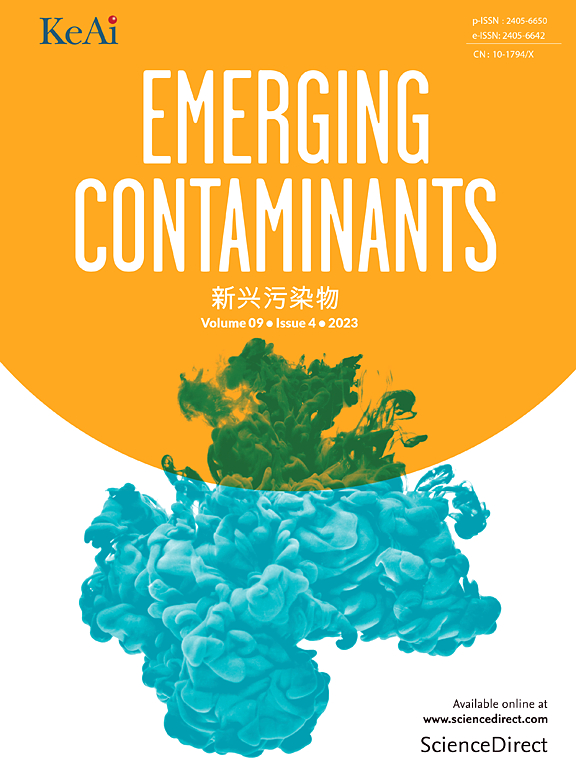南非环境水域中遗留、前体和新出现的全氟烷基和多氟烷基物质的分布及其对人口的潜在健康风险
IF 6.9
2区 环境科学与生态学
Q1 ENVIRONMENTAL SCIENCES
引用次数: 0
摘要
我们提出了一项研究的全氟烷基和多氟烷基物质(PFASs)的水样从48个地点在南非8个省。采用固相萃取(SPE)后的液相色谱-串联质谱法(LC-MS/MS)对26种靶向PFASs进行分析。在检测到的不同PFAS类别中,PFAS前体8:2氟端粒醇(8:2 FTOH)是检测到的最突出的PFAS,其总浓度(∑8:2 FTOH,所有位点)为1042.1 ng L−1(平均值= 4.9 ng L−1,中位数= 1.1 ng L−1)。相比之下,最主要的遗留PFAS是PFBA,其总浓度(∑PFBA,所有位点)为8174.8 ng L−1(平均值= 146.7 ng L−1,中位数= 25.7 ng L−1)。在全氟辛烷磺酸中,全氟羧酸(PFCAs)是检出最多的全氟辛烷磺酸,尽管平均浓度没有统计学意义(p >;0.05)。各省份的浓度在季节上存在差异,但总体上雨季浓度高于旱季。此外,PFASs的检测频率(DF%)各不相同,仅在旱季检测达到70%。由于南非从未生产过全氟辛烷磺酸,因此全氟辛烷磺酸污染的潜在来源与可能在采样点周围使用的含有全氟辛烷磺酸的产品有关。确定的潜在来源是家庭和工业排放、农业活动、废水排放和其他人为活动。长链遗留全氟辛烷磺酸的不占主导地位可能表明氟化替代品的使用发生了转变。这种趋势也可能是由于长链PFAS吸附在固体上,如水生环境中的沉积物。此外,经健康评估,受污染地表水对人类造成的全氟辛烷酸(PFOA)和全氟辛烷磺酸(PFOS)的风险为低至中等水平,其余化合物在检测到的浓度下未观察到重大风险。本文章由计算机程序翻译,如有差异,请以英文原文为准。
Distribution of legacy, precursor and emerging per-and polyfluoroalkyl substances in environmental waters in South Africa and their potential health risk to the population
We present a study of per-and polyfluoroalkyl substances (PFASs) in water samples from 48 sites in 8 South African provinces. Twenty-six targeted PFASs were analysed using liquid chromatography-tandem mass spectrometry (LC-MS/MS), after solid phase extraction (SPE). Of the different PFAS classes detected, the PFAS precursor 8:2 Fluorotelomer alcohol (8:2 FTOH) was among the prominent PFAS detected, with the sum concentration (∑8:2 FTOH, all sites) of 1042.1 ng L−1 (mean = 4.9 ng L−1, median = 1.1 ng L−1). In comparison, the most dominant legacy PFAS was PFBA, with the sum concentration (∑PFBA, all sites) of 8174.8 ng L−1 (mean = 146.7 ng L−1, median = 25.7 ng L−1). Out of the groups of PFASs, perfluorocarboxylic acids (PFCAs) were the most detected PFASs, though the average concentrations were not statistically significant (p > 0.05) between all the provinces assessed. Seasonally, the individual concentrations varied in each province, but generally, the concentrations were higher during the wet season than the dry season. Moreover, detection frequency (DF%) amongst the PFASs varied with only detections during the dry season achieving >70 %. Since PFASs were never manufactured in South Africa, the potential sources of PFAS contamination were linked to the use of PFAS containing products that may be used in the surroundings of the sampling sites. The potential sources identified were domestic and industrial discharges, agricultural activities, wastewater effluents and other anthropogenic activities. The non-dominance of the long-chain legacy PFASs may indicate a shift on the use of fluorinated alternatives. The trend could also be due to long chain PFAS adsorption on to solids such as sediments in the aquatic environment. In addition, the health assessment risk to humans from contaminated surface water was low to moderate for perfluorooctanoic acid (PFOA) and perfluorooctanesulfonic acid (PFOS), and no significant risk was observed for the rest of the compounds at the detected concentrations.
求助全文
通过发布文献求助,成功后即可免费获取论文全文。
去求助
来源期刊

Emerging Contaminants
Medicine-Public Health, Environmental and Occupational Health
CiteScore
10.00
自引率
6.70%
发文量
35
审稿时长
44 days
期刊介绍:
Emerging Contaminants is an outlet for world-leading research addressing problems associated with environmental contamination caused by emerging contaminants and their solutions. Emerging contaminants are defined as chemicals that are not currently (or have been only recently) regulated and about which there exist concerns regarding their impact on human or ecological health. Examples of emerging contaminants include disinfection by-products, pharmaceutical and personal care products, persistent organic chemicals, and mercury etc. as well as their degradation products. We encourage papers addressing science that facilitates greater understanding of the nature, extent, and impacts of the presence of emerging contaminants in the environment; technology that exploits original principles to reduce and control their environmental presence; as well as the development, implementation and efficacy of national and international policies to protect human health and the environment from emerging contaminants.
 求助内容:
求助内容: 应助结果提醒方式:
应助结果提醒方式:


